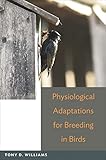Physiological adaptations for breeding in birds [Libro electrónico] / Tony D. Williams
Por: Williams, Tony D [autor/a].
Tipo de material: Libro
en línea Editor: Princeton, New Jersey, United States: Princeton University Press, c2012Descripción: xviii, 368 páginas : ilustraciones ; 24 centímetros.ISBN: 9780691139821; 9781400842797.Tema(s): Birds -- Reproduction | Females | Birds -- Physiology | Adaptation (Physiology) | Phenotype | Birds -- Variation | Birds -- EcologyNota de acceso: Disponible para usuarios de ECOSUR con su clave de acceso Nota de bibliografía: Incluye bibliografía e índice: páginas 299-360 Número de sistema: 54870Resumen:
Libro
en línea Editor: Princeton, New Jersey, United States: Princeton University Press, c2012Descripción: xviii, 368 páginas : ilustraciones ; 24 centímetros.ISBN: 9780691139821; 9781400842797.Tema(s): Birds -- Reproduction | Females | Birds -- Physiology | Adaptation (Physiology) | Phenotype | Birds -- Variation | Birds -- EcologyNota de acceso: Disponible para usuarios de ECOSUR con su clave de acceso Nota de bibliografía: Incluye bibliografía e índice: páginas 299-360 Número de sistema: 54870Resumen:| Tipo de ítem | Biblioteca actual | Colección | Signatura | Estado | Fecha de vencimiento | Código de barras |
|---|---|---|---|---|---|---|
| Libros | Biblioteca Electrónica Recursos en línea (RE) | Acervo General | Recurso digital | ECO400548703139 |
Incluye bibliografía e índice: páginas 299-360
Disponible para usuarios de ECOSUR con su clave de acceso
Physiological Adaptations for Breeding in Birdsis the most current and comprehensive account of research on avian reproduction. It develops two unique themes: the consideration of female avian reproductive physiology and ecology, and an emphasis on individual variation in life-history traits. Tony Williams investigates the physiological, metabolic, energetic, and hormonal mechanisms that underpin individual variation in the key female-specific reproductive traits and the trade-offs between these traits that determine variation in fitness. The core of the book deals with the avian reproductive cycle, from seasonal gonadal development, through egg laying and incubation, to chick rearing. Reproduction is considered in the context of the annual cycle and through an individual's entire life history. The book focuses on timing of breeding, clutch size, egg size and egg quality, and parental care. It also provides a primer on female reproductive physiology and considers trade-offs and carryover effects between reproduction and other life-history stages. In each chapter, Williams describes individual variation in the trait of interest and the evolutionary context for trait variation. He argues that there is only a rudimentary, and in some cases nonexistent, understanding of the physiological mechanisms that underpin individual variation in the major reproductive life-history traits, and that research efforts should refocus on these key unresolved problems by incorporating detailed physiological studies into existing long-term population studies, generating a new synthesis of physiology, ecology, and evolutionary biology. eng
Disponible en línea
Adobe Acrobat profesional 6.0 o superior
Subscripción a ELSEVIER 26 de diciembre del 2013
